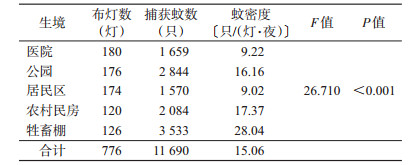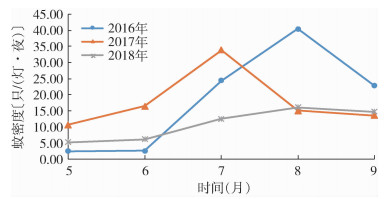
扩展功能
文章信息
- 虎明明, 郑艳娟, 吴建华, 谭玉臻
- HU Ming-ming, ZHENG Yan-juan, WU Jian-hua, TAN Yu-zhen
- 银川市3个区2016-2018年蚊虫监测分析
- Results and analysis of mosquito density monitoring in three districts of Yinchuan, Ningxia, China, 2016-2018
- 中国媒介生物学及控制杂志, 2020, 31(3): 370-372
- Chin J Vector Biol & Control, 2020, 31(3): 370-372
- 10.11853/j.issn.1003.8280.2020.03.026
-
文章历史
- 收稿日期: 2019-12-18
随着环境变化和社会发展, 虫媒传染病也越来越受到人们的关注。2018年银川市暴发流行性乙型脑炎(乙脑), 既损害了公众健康, 又耗费了大量人力、物力和财力。增加监测点的覆盖面及监测频率, 加大消杀力度, 控制蚊密度, 提高群众对虫媒传染病的认识水平刻不容缓。
1 材料与方法 1.1 资料来源按照《宁夏病媒生物监测方案》的要求, 参考银川市的蚊虫活动规律, 2016-2018年每年5月开始监测, 在银川市3个国家级监测点兴庆、西夏和金凤区分别于城区(城镇居民区、公园、医院)和农村(民房、牲畜棚)5类调查点各选择2个为监测点, 每个监测点布放1盏诱蚊灯(型号:M02B, 额定电压为220 V/50 Hz, 功率为24 W, 风速为1.4 m/s), 每月上旬、下旬各监测1次。
1.2 监测方法成蚊监测采用诱蚊灯法[1]。选择远离干扰光源和避风的场所作为挂灯点, 诱蚊灯光源离地1.5 m, 每处监测生境放置诱蚊灯1盏, 监测从日落前1 h开始, 连续诱集12 h, 直至次日日出后1 h, 密闭收集器后, 再关闭电源, 将集蚊盒取出, 乙醚麻醉或冷冻处死, 鉴定种类、性别并计数。
1.3 统计学分析采用SPSS 17.0软件进行统计分析, 计数资料率的比较采用χ2检验, P < 0.05为差异有统计学意义。
2 结果 2.1 蚊密度及蚊种构成共捕获蚊虫11 690只, 平均蚊密度为15.06只(/灯·夜), 蚊密度从高到低依次为金凤、西夏和兴庆区, 不同地区蚊密度差异有统计学意义(F=21.562, P < 0.001), 见表 1。不同年度的蚊种构成比不同(χ2=570.738, P < 0.001), 淡色(致倦)库蚊(Culex pipiens pallens/Cx. pipiens quinquefasciatus)为优势蚊种, 见表 2。

|

|
不同生境蚊密度差异有统计学意义(F=26.710, P < 0.001), 牲畜棚、农村民房和公园蚊密度相对较高, 见表 3。

|
2016-2018年蚊密度差异有统计学意义(F=11.722, P=0.009), 2017年蚊密度最高, 见表 4。蚊密度在7和8月出现高峰, 见图 1。

|

|
| 图 1 2016-2018年银川市兴庆、西夏和金凤3个区不同月份蚊密度监测结果 Figure 1 Surveillance results of mosquito density in different months from 2016 to 2018 in Xingqing, Xixia, and Jinfeng districts of Yinchuan |
| |
银川市是宁夏回族自治区首府, 位于中国西北, 中温带大陆性气候, 四季分明, 昼夜温差大, 雨雪稀少, 蒸发强烈, 气候干燥。年平均气温8.5℃左右, 年平均降水量200 mm左右。而银川市地表水水源充足, 有"塞上湖城"的美誉, 适合病媒生物的生长繁殖。
从监测结果来看, 2016-2018年银川市3个区平均蚊密度为15.06只/(灯·夜), 高于全国其他地区[2-5], 淡色(致倦)库蚊为优势蚊种, 可能与银川市地表水较多、温湿度适宜蚊虫繁殖有关。不同生境蚊密度为牲畜棚>农村民房>公园>医院>居民区, 这也与上述报道结果基本一致。蚊类在7和8月出现高峰, 可能与银川市7和8月气温较高, 降水量较多有关。不同年份蚊种构成不同, 可能与银川市近年来降水量、牲畜养殖业及采用的消杀药品增加等因素有关, 而影响蚊虫种群和数量的因素很多, 主要包括孳生场所的蚊虫种类和数量, 经纬度、湿温度以及防制措施等[6]。而三带喙库蚊(Cx. tritaeniorhynchus)所占比例增高, 是2018年银川市蚊虫传播疾病乙脑暴发的重要原因。
通过分析监测结果, 基本掌握了银川市3个区蚊虫的种群密度和季节消长规律, 据此建议以牲畜棚和农村民房为消杀重点区域, 7和8月为重点控制蚊密度上升的时期, 同时加强对蚊虫及其传染病的长期监测、预警、控制对策和措施的研究。采取加大监测力度及环境治理措施, 控制蚊密度水平, 提高群众对虫媒传染病的认识等病媒生物综合防治机制。结合银川市抗药性监测结果[7], 为今后开展有效的蚊虫防制, 降低虫媒传染病提供科学依据。
| [1] |
中国国家标准化管理委员会. GB/T23797-2009病媒生物密度监测方法蚊虫[S].北京: 中国标准出版社, 2009. Standardization Administration of the People's Republic of China. GB/T 23797-2009 Surveillance methods for vector density-mosquito[S]. Beijing: China Standard Press, 2009. |
| [2] |
明明, 马德珍, 赵爱华, 等. 泰安市蚊密度季节消长及其抗药性分析[J]. 中华卫生杀虫药械, 2016, 22(4): 375-377. Ming M, Ma DZ, Zhao AH, et al. Seasonal fluctuation of mosquito density and its resistance analysis in Tai'an city[J]. Chin J Hyg Insect Equip, 2016, 22(4): 375-377. |
| [3] |
贺洪国, 刘硕, 李宏通, 等. 北京市昌平区2014年蚊密度季节消长调查[J]. 中国媒介生物学及控制杂志, 2015, 26(5): 535. He HG, Liu S, Li HT, et al. Investigation on seasonal fluctuation of mosquito density in Changping district, Beijing in 2014[J]. Chin J Vector Biol Control, 2015, 26(5): 535. DOI:10.11853/j.issn.1003.4692.2015.05.031 |
| [4] |
郝海波, 夏世国, 吴克利. 2014-2016年荆州城区蚊密度监测分析[J]. 中华卫生杀虫药械, 2017, 23(6): 566-568. Hao HB, Xia SG, Wu KL. Analysis on the mosquito density monitoring in Jingzhou city from 2014 to 2016[J]. Chin J Hyg Insect Equip, 2017, 23(6): 566-568. |
| [5] |
唐振强, 郭祥树, 刘吉起. 河南省2012-2015年蚊密度监测及季节消长分析[J]. 中华卫生杀虫药械, 2016, 22(5): 485-486, 489. Tang ZQ, Guo XS, Liu JQ. Population structure and seasonal fluctuations of mosquitoes in Henan province from 2012 to 2015[J]. Chin J Hyg Insect Equip, 2016, 22(5): 485-486, 489. |
| [6] |
瞿逢伊. 我国蚊类研究五十年[J]. 中国寄生虫学与寄生虫病杂志, 1999, 17(5): 264-266. Qu FY. Fifty Years of mosquito research in China[J]. Chin J Parasitol Parasit Dis, 1999, 17(5): 264-266. |
| [7] |
郑燕娟, 虎明明, 吴建华. 银川市2017年淡色库蚊抗药性监测分析[J]. 中国媒介生物学及控制杂志, 2018, 29(5): 544. Zheng YJ, Hu MM, Wu JH. Surveillance and analysis of insecticide resistance to Culex pipiens pallens in Yinchuan city in 2017[J]. Chin J Vector Biol Control, 2018, 29(5): 544. DOI:10.11853/j.issn.1003.8280.2018.05.033 |
 2020, Vol. 31
2020, Vol. 31



